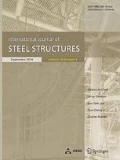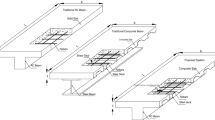Abstract
A new type of composite slab is introduced in this paper, which is composed of normal flat steel plates and concrete slabs, connected and interacted by perfobond shear connectors (PBL shear connectors). Experiments on six specimens of this type of composite slab, loaded at two symmetric two-points, were described in this paper to get mechanical behaviors under bending moments. During the experiments, the crack patterns, failure modes, failure mechanism and ultimate bending capacity of specimens with composite slab were investigated, and the strains of concrete and flat steel plates were also measured and recorded in order to obtain the moment action. From the experimental results, it was found that composite interaction between the steel plate and the concrete fully developed, and such composite slab was verified to have good mechanical performance with high bending capacity, substantial flexural rigidity and good ductility. Plane section assumption was also verified and moreover, a design approach including calculation methods of bending capacity and flexural rigidity was established and proposed based on the experimental results, and the calculation methods were also verified and revised on the basis of comparisons of the calculated results and experimental results. Results from this paper provide references for the application of this new type composite slab.
















Similar content being viewed by others
References
Allahyari, H., Dehestani, M., Beygi, M. H., Neya, B. W., & Rahmani, E. (2014). Mechanical behavior of steel-concrete composite decks with perfobond shear connectors. Steel and Composite Structures, 17(3), 339–358.
Egilmez, O. O., Helwig, T. A., Jetann, C. A., & Lowery, R. (2007). Stiffness and strength of metal bridge deck forms. Journal of Bridge Engineering, 12(4), 429–437.
Hu X. L., Lin Y., & Wang Q. Y. (2013). Experimental analysis of perfonbond shear connection between steel and pre-stressed concrete. In The 2013 world congress on advances in structural engineering and mechanics (pp. 190–198). Jeju, Korea.
Johnson, R. P. (2004). Prediction of shear resistance of headed studs in troughs of profiled sheeting. Oxford: Blackwell Pub.
Johnson R. P. (2011). Composite structures of steel and concrete: beams, slabs, columns, and frames for buildings. Composite Construction in Steel and Concrete VI, pp. 1–13.
Kozioł, P. (2015). Modern design of steel-concrete composite structures. Modern design of steel-concrete composite structures, 21(171), 118–127.
Leon, R. T. (2004). Composite construction in steel and concrete V. In Proceedings of the 5th international conference, July 18–23, Kruger National Park, Berg-en-Dal, Mpumalanga, South Africa.
Leon, R. T. (2008). Composite construction in steel and concrete VI. In Proceedings of the 2008 composite construction in steel and concrete conference, July 20–24, Tabernash, Colorado.
Li, S. Q., Wan, S., & Chen, J. B. (2009). Test study of a new type of shear connector. International Journal of Bridge Construction, 2009(04), 17–19.
Nie, J. G., Yi, W. H. J., & Lei, L. Y. (2003). Rigidity calculation of closed profiled sheeting-concrete composite slabs. Industrial Construction, 33(12), 19–21.
Nishiumi, K., & Okimoto, M. (1999). Shear strength of perfobond rib shear connector under the confinement. International Journal of Japanese Society of Civil Engineering, 633, 193–203.
Oehlers, D. J., & Bradford, M. A. (1995). composite steel and concrete structural members-fundamental behavior. Pergamon, Oxford: Elsevier Science.
Papastergiou, D., & Lebet, J. P. (2014). Investigation of a new steel-concrete connection for composite bridges. Steel and Composite Structures, 17(5), 573–599.
Rackham, J. W., Couchman, G. H., & Hicks, S. J. (2009). Composite slabs and beams using steel decking: Best practice for design and construction. UK: Steel Construction Institute.
Ren, J. (2006). Experimental study on fatigue behaviors of steel-concrete composite structures. Master. Dissertation, Southwest Jiaotong University, China. (in Chinese).
Uy, B., & Bradford, M. A. (1994). Inelastic local buckling behavior of thin steel plates in profiled composite beams. The Structural Engineer, 72(16), 259–267.
Wang, W. A., Li, Q., Zhao, C. H., & Zhuang, W. L. (2014). Experimental study on bearing capacity of PBL shear connector group in hybrid structures. China Civil Engineering Journal, 47(6), 109–117. (in Chinese).
Wen, X., Ye, J. S., Gai, X. M., & Cai, C. S. (2013). Mechanical performance and design optimization of rib-stiffened super-wide bridge deck with twin box girders in concrete. Structural Engineering and Mechanics, 48(3), 395–414.
Wu, H., & Hosain, M. U. (2002).Composite beams with parallel wide ribbed metal deck. Composite Construction in Steel and Concrete VI, pp. 415–425.
Yang, Y., & Huo, X. D. (2011). Experimental study on fatigue behavior of steel plate-concrete composite bridge decks. Engineering Mechanics, 28(8), 37–45. (in Chinese).
Yang, Y., Liu, J. B., Fan, J. S., & Nie, X. (2013). Experimental study on flexural capacity of steel plate-concrete composite slabs. Journal of Building Structures, 34(10), 24–31. (in Chinese).
Yang, Y., Yu, Y. L., Zhou, X. W., Roeder, C. W., & Huo, X. D. (2016). Study on mechanism performance of composite beam with innovative composite slabs. Steel and Composite Structures, 21(3), 537–551.
Yang, Y., Zhou, X. W., Xue, J. Y., & Huo, X. D. (2012). Experimental study on fatigue behavior of composite girders with steel plate-concrete composite decks. China Civil Engineering Journal, 45(6), 135–141. (in Chinese).
Yang, Y., Zhu, G., Zhou, P. J., Nie, J. G., et al. (2009). Experimental study on the mechanical behavior and design method of plane steel-plate and concrete composite bridge decks. China Civil Engineering Journal, 42(12), 135–141. (in Chinese).
Yeol, H., & Jeong, Y. J. (2006). Experimental investigation on behavior of steel–concrete composite bridge decks with perfobond ribs. Journal of Construction Steel Research, 62(5), 463–471.
Zhan, Y. L., & Zhao, R. D. (2006). Experimental study and theoretical analysis on steel-concrete composite bridge decks. Journal of Southwest Jiaotong University, 41(3), 360–365. (in Chinese).
Acknowledgements
The experiments were sponsored by the National Natural Science Foundation of China (Program Nos. 50708,040 and 50978107) and supported by the Program for Changjiang Scholars and Innovative Research Team at the University of China as well as the Program for Innovative Research Team of Xi’an University of Architecture and Technology.
Author information
Authors and Affiliations
Corresponding author
Rights and permissions
About this article
Cite this article
Yang, Y., Liu, R., Huo, X. et al. Static Experiment on Mechanical Behavior of Innovative Flat Steel Plate-Concrete Composite Slabs. Int J Steel Struct 18, 473–485 (2018). https://doi.org/10.1007/s13296-018-0012-3
Received:
Accepted:
Published:
Issue Date:
DOI: https://doi.org/10.1007/s13296-018-0012-3




